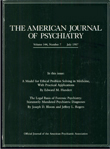5-HT1D Function and Repetitive Behaviors
To the Editor: In a recent article, Emanuela Mundo, M.D., et al. (1) reported a significant linkage disequilibrium between the G861C variant of the serotonin 5-HT1Dβ receptor gene and obsessive-compulsive disorder (OCD). This is of interest given reports that the 5-HT1D agonist sumatriptan may improve the symptoms of OCD (2). However, although the effect of the presence of the G variant of the 5-HT1Dβ receptor gene increases the risk of developing OCD by 5.26-fold, the authors acknowledged that OCD is complex and more than one gene is expected to contribute to its etiology. Each gene has only a relatively small effect in increasing the risk for the disorder.
The OCD phenotype is heterogeneous, and it is possible that transmission disequilibrium of the 5-HT1D receptor gene may be more closely related to certain behavioral patterns, such as repetitive or compulsive behaviors per se, rather than to a categorical disorder, such as DSM-IV OCD. A neuroscientifically based psychopathology attempted to transcend the boundaries of convenience that permit reliable categorizations because these categories may not have any inherent biological meaning (3). For this reason, it is of interest to explore whether 5-HT1D function is related to the severity of repetitive behaviors across other neuropsychiatric disorders that cross categorical boundaries.
There is a higher rate of OCD in first-degree family members of autistic probands (4), and parents with high levels of repetitive behaviors have higher whole-blood 5-HT levels (5). Recently, we reported that in autistic patients, a high level of severe repetitive behaviors correlated with higher 5-HT1D sensitivity, as manifested by the response of growth hormone to sumatriptan (6). Thus, one component of 5-HT function, 5-HT1D sensitivity, may play a role in mediating one specific behavioral domain within autism—repetitive behaviors—thus influencing heterogeneity in autism.
Future studies might examine the role of 5-HT1D receptor gene function and the repetitive behavior domain, not only within OCD but across other disorders in which this clinical symptom is a key symptom component.
1. Mundo E, Richter MA, Sam F, Macciardi F, Kennedy JL: Is the 5-HT1Dβ receptor gene implicated in the pathogenesis of obsessive-compulsive disorder? Am J Psychiatry 2000; 157:1160–1161Google Scholar
2. Stern L, Zohar J, Cohen R, Sasson Y: Treatment of severe, drug resistant obsessive compulsive disorder with the 5-HT1D agonist sumatriptan. Eur Neuropsychopharmacol 1998; 8:325–328Crossref, Medline, Google Scholar
3. Andreasen NC: Linking mind and brain in the study of mental illnesses: a project for a scientific psychopathology. Science 1997; 275:1586–1593Google Scholar
4. Bolton PF, Pickles A, Murphy M, Rutter M: Autism, affective and other psychiatric disorders: patterns of familial aggregation. Psychol Med 1998; 28:385–395Crossref, Medline, Google Scholar
5. Cook EH, Charak DA, Aridaa J, Spohn JA, Roizen NJM, Leventhal BL: Depressive and obsessive-compulsive symptoms in hyperserotonemic parents of children with autistic disorder. Mol Psychiatry 1994; 2:247–250Google Scholar
6. Hollander E, Novotny S, Allen A, Aronowitz B, Cartwright C, DeCaria C: The relationship between repetitive behaviors and growth hormone response to sumatriptan challenge in adult autistic disorder. Neuropsychopharmacology 2000; 22:163–167Crossref, Medline, Google Scholar



